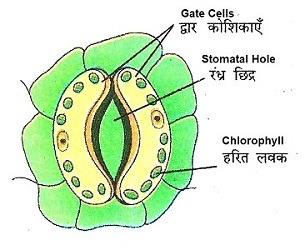प्रश्न 1. रन्ध्र कहाँ पाये जाते हैं? इनकी संरचना तथा कार्य का सचित्र वर्णन कीजिए।
Where are stomata found? Describe their structure and function pictorially.
(अथवा) रन्ध्रीय वाष्पोत्सर्जन क्रिया-विधि का सचित्र वर्णन कीजिए।
(OR) Describe pictorially the mechanism of stomatal transpiration.
उत्तर- रन्ध्र- पौधे के हरे वायवीय भागों में रन्ध्र पाये जाते हैं। पत्तियों की सतह पर रन्ध्रों की संख्या औसतन 250 से 300 प्रति वर्ग मिमी होती है। यह संख्या न्यूनतम 14 और अधिकतम 1038 प्रति वर्ग मिमी हो सकती है। रन्ध्र पत्ती की सतह का औसतन 1-2 प्रतिशत क्षेत्र घेरते हैं।
Stomata- Stomata are found in the green aerial parts of the plant. The number of stomata on the surface of leaves is on an average 250 to 300 per square mm. This number can be a minimum of 14 and a maximum of 1038 per square mm. Stomata occupy an average of 1-2 percent of the leaf surface area.
रन्ध्र की संरचना ,Structure of stomata
रन्ध्र रक्षक या द्वार कोशिकाओं से घिरे रहते हैं। द्वार कोशिकाएँ सहायक या अधिचर्म कोशिकाओं से घिरी रहती हैं। द्वार कोशिकाएँ रन्ध्र के खुलने तथा बन्द होने की क्रिया पर नियन्त्रण रखती हैं। द्वार कोशिकाओं की भीतरी भित्ति स्थूलित तथा बाह्य भित्ति पतली होती है। द्वार कोशिकाओं में हरितलवक पाये जाते हैं। रन्ध्रों के नीचे एक छोटी-सी अधोरन्ध्री गुहा होती है। द्वार कोशिकाओं के स्फीत होने पर रन्ध्र खुल जाते हैं और श्लथ होने पर बन्द हो जाते हैं। रन्ध्र प्राय: दिन में खुले रहते हैं और रात में बन्द हो जाते हैं।
रन्ध्र पृष्ठाधारी पत्तियों की निचली सतह पर सामान्यतया अधिक संख्या में पाये जाते हैं। समद्विपार्श्वीय पत्तियों की दोनों सतहों पर यों की संख्या लगभग समान होती है। मरुद्भिद पौधों में रन्ध्र गड्ढों में धँसे रहते हैं। इसके फलस्वरूप वाष्पोत्सर्जन की दर कम हो जाती है; जैसे- कनेर, चीड़, घीग्वार आदि ।
Stomata are surrounded by guard or guard cells. Guard cells are surrounded by supporting or epidermal cells. Guard cells control the opening and closing of the stomata. The inner wall of guard cells is thick and the outer wall is thin. Chloroplasts are found in guard cells. There is a small substomatal cavity below the stomata. Stomata open when the guard cells swell and close when they relax. Stomata usually remain open during the day and close at night.
Stomata are generally found in large numbers on the lower surface of dorsal leaves. The number of cells on both surfaces of bilateral leaves is almost equal. In xerophytic plants, the stomata remain buried in pits. As a result, the rate of transpiration reduces; Like- Kaner, Chir, Gheegwar etc.

स्टार्च-शर्करा परिवर्तन मत,Starch-sugar transformation:
सेयरे (Sayre, 1972) के अनुसार रक्षक कोशिकाओं के pH मान में परिवर्तन होने से रन्ध्र खुलते और बन्द होते हैं। दिन के समय pH मान अधिक होता है। प्रकाश-संश्लेषण के फलस्वरूप बना ग्लूकोज ए०टी०पी० के फॉस्फेट से क्रिया करके ग्लूकोज-1-फॉस्फेट बनाता है तथा रक्षक कोशिकाओं का स्टार्च फॉस्फोरिलेज एन्जाइम के कारण अकार्बनिक फॉस्फेट से क्रिया करके ग्लुकोज-1-फॉस्फेट में बदल जाता है। इसके फलस्वरूप रक्षक कोशिकाओं की सान्द्रता बढ़ जाती है। अन्त: परासरण के फलस्वरूप रक्षक कोशिकायें स्फीत हो जाती हैं और रन्ध्र खुल जाते हैं।
रात्रि में pH मान कम होने के कारण फॉस्फोरिलेज एन्जाइम ग्लूकोज-1-फॉस्फेट को अघुलनशील स्टार्च में बदल देता है। सान्द्रता कम हो जाने से बहि:परासरण के कारण रक्षक कोशिकायें श्लथ दशा में आ जाती हैं और रन्ध्र बन्द हो जाते हैं।
According to Sayre (1972), stomata open and close due to change in pH value of guard cells. The pH value is higher during the day. Glucose produced as a result of photosynthesis reacts with the phosphate of ATP to form glucose-1-phosphate and due to the starch phosphorylase enzyme of the guard cells, it reacts with inorganic phosphate and gets converted into glucose-1-phosphate. As a result, the concentration of protective cells increases. As a result of endosmosis, the guard cells swell and the stomata open.
Due to low pH value at night, phosphorylase enzyme converts glucose-1-phosphate into insoluble starch. Due to decrease in concentration, due to osmosis, the guard cells become inactive and the stomata get closed.
रन्ध्रों के कार्य,Functions of stomata
1. रन्ध्रों द्वारा CO2 तथा O2 का आदान-प्रदान होता है
2. रन्ध्रों द्वारा वाष्पोत्सर्जन होता है।
3. रन्ध्रों की संख्या तथा स्थिति वाष्पोत्सर्जन की दर को नियन्त्रित करती है।
Exchange of CO2 and O2 takes place through stomata.
Transpiration occurs through stomata.
The number and position of stomata controls the rate of transpiration.




